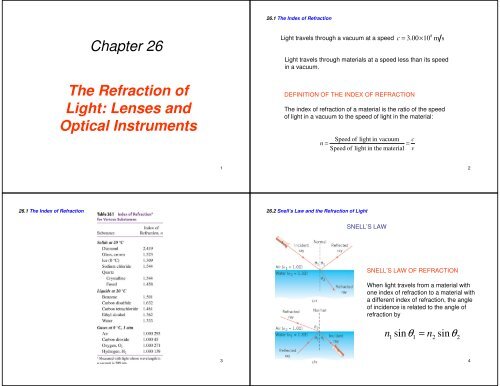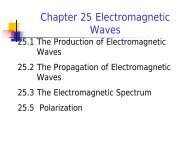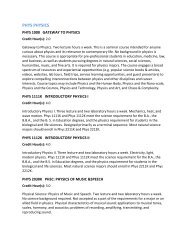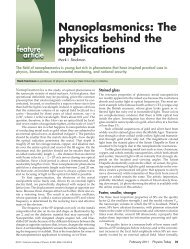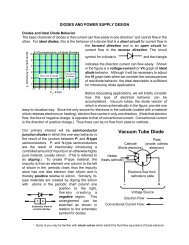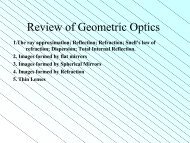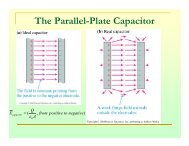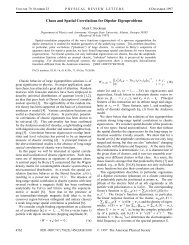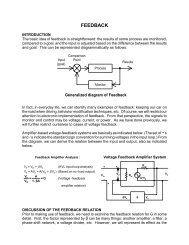Chapter 26 The Refraction of Light: Lenses and Optical Instruments
Chapter 26 The Refraction of Light: Lenses and Optical Instruments
Chapter 26 The Refraction of Light: Lenses and Optical Instruments
You also want an ePaper? Increase the reach of your titles
YUMPU automatically turns print PDFs into web optimized ePapers that Google loves.
<strong>26</strong>.1 <strong>The</strong> Index <strong>of</strong> <strong>Refraction</strong><br />
<strong>Chapter</strong> <strong>26</strong><br />
<strong>The</strong> <strong>Refraction</strong> <strong>of</strong><br />
<strong>Light</strong>: <strong>Lenses</strong> <strong>and</strong><br />
<strong>Optical</strong> <strong>Instruments</strong><br />
<strong>Light</strong> travels through a vacuum at a speed c = 3.00×<br />
10<br />
8<br />
m s<br />
<strong>Light</strong> travels through materials at a speed less than its speed<br />
in a vacuum.<br />
DEFINITION OF THE INDEX OF REFRACTION<br />
<strong>The</strong> index <strong>of</strong> refraction <strong>of</strong> a material is the ratio <strong>of</strong> the speed<br />
<strong>of</strong> light in a vacuum to the speed <strong>of</strong> light in the material:<br />
Speed <strong>of</strong> light in vacuum<br />
n =<br />
=<br />
Speed <strong>of</strong> light in the material<br />
c<br />
v<br />
1<br />
2<br />
<strong>26</strong>.1 <strong>The</strong> Index <strong>of</strong> <strong>Refraction</strong><br />
<strong>26</strong>.2 Snell’s Law <strong>and</strong> the <strong>Refraction</strong> <strong>of</strong> <strong>Light</strong><br />
SNELL’S LAW<br />
SNELL’S LAW OF REFRACTION<br />
When light travels from a material with<br />
one index <strong>of</strong> refraction to a material with<br />
a different index <strong>of</strong> refraction, the angle<br />
<strong>of</strong> incidence is related to the angle <strong>of</strong><br />
refraction by<br />
n θ =<br />
1<br />
sin<br />
1<br />
n2<br />
sin<br />
θ<br />
2<br />
3<br />
4
<strong>26</strong>.2 Snell’s Law <strong>and</strong> the <strong>Refraction</strong> <strong>of</strong> <strong>Light</strong><br />
<strong>26</strong>.2 Snell’s Law <strong>and</strong> the <strong>Refraction</strong> <strong>of</strong> <strong>Light</strong><br />
Example 1 Determining the Angle <strong>of</strong> <strong>Refraction</strong><br />
A light ray strikes an air/water surface at an<br />
angle <strong>of</strong> 46 degrees with respect to the<br />
normal. Find the angle <strong>of</strong> refraction when<br />
the direction <strong>of</strong> the ray is (a) from air to<br />
water <strong>and</strong> (b) from water to air.<br />
(a)<br />
n1<br />
sinθ1<br />
sinθ<br />
= =<br />
n<br />
( 1.00)<br />
sin 46<br />
1.33<br />
o<br />
2<br />
=<br />
2<br />
θ ( )<br />
= 33 o<br />
2<br />
0.54<br />
(b)<br />
n1<br />
sinθ1<br />
sinθ<br />
= =<br />
n<br />
1.33 sin 46<br />
1.00<br />
o<br />
2<br />
=<br />
2<br />
0.96<br />
θ = 74 o<br />
2<br />
5<br />
6<br />
<strong>26</strong>.2 Snell’s Law <strong>and</strong> the <strong>Refraction</strong> <strong>of</strong> <strong>Light</strong><br />
<strong>26</strong>.2 Snell’s Law <strong>and</strong> the <strong>Refraction</strong> <strong>of</strong> <strong>Light</strong><br />
APPARENT DEPTH<br />
Example 2 Finding a Sunken Chest<br />
<strong>The</strong> searchlight on a yacht is being used to illuminate a sunken<br />
chest. At what angle <strong>of</strong> incidence should the light be aimed?<br />
n<br />
sinθ<br />
=<br />
−<br />
o<br />
( )<br />
o<br />
2<br />
sinθ2<br />
( 1.33)<br />
sin 31<br />
=<br />
0.69<br />
n1<br />
1.00<br />
θ<br />
1<br />
=<br />
= 44 o<br />
1<br />
θ tan 1<br />
2<br />
= 2.0 3.3 = 31<br />
7<br />
8
<strong>26</strong>.2 Snell’s Law <strong>and</strong> the <strong>Refraction</strong> <strong>of</strong> <strong>Light</strong><br />
<strong>26</strong>.2 Snell’s Law <strong>and</strong> the <strong>Refraction</strong> <strong>of</strong> <strong>Light</strong><br />
Conceptual Example 4 On the Inside Looking Out<br />
Apparent depth,<br />
observer directly<br />
above object<br />
A swimmer is under water <strong>and</strong> looking up at the surface. Someone<br />
holds a coin in the air, directly above the swimmer’s eyes. To the<br />
swimmer, the coin appears to be at a certain height above the<br />
water. Is the apparent height <strong>of</strong> the coin greater, less than, or the<br />
same as its actual height?<br />
⎛ n<br />
d′<br />
= d<br />
⎜<br />
⎝ n<br />
2<br />
1<br />
⎞<br />
⎟<br />
⎠<br />
9<br />
10<br />
<strong>26</strong>.2 Snell’s Law <strong>and</strong> the <strong>Refraction</strong> <strong>of</strong> <strong>Light</strong><br />
<strong>26</strong>.2 Snell’s Law <strong>and</strong> the <strong>Refraction</strong> <strong>of</strong> <strong>Light</strong><br />
THE DISPLACEMENT OF LIGHT BY A SLAB OF MATERIAL<br />
THE DERIVATIN OF SNELL’S LAW<br />
11<br />
12
<strong>26</strong>.3 Total Internal Reflection<br />
When light passes from a medium <strong>of</strong> larger refractive index into one<br />
<strong>of</strong> smaller refractive index, the refracted ray bends away from the<br />
normal.<br />
<strong>26</strong>.3 Total Internal Reflection<br />
Example 5 Total Internal Reflection<br />
A beam <strong>of</strong> light is propagating through diamond <strong>and</strong> strikes the diamond-air<br />
interface at an angle <strong>of</strong> incidence <strong>of</strong> 28 degrees. (a) Will part <strong>of</strong> the beam<br />
enter the air or will there be total internal reflection? (b) Repeat part (a)<br />
assuming that the diamond is surrounded by water.<br />
Critical angle<br />
sinθ<br />
n<br />
2<br />
c<br />
= n1<br />
><br />
n1<br />
n<br />
2<br />
13<br />
14<br />
<strong>26</strong>.3 Total Internal Reflection<br />
<strong>26</strong>.3 Total Internal Reflection<br />
Conceptual Example 6 <strong>The</strong> Sparkle <strong>of</strong> a Diamond<br />
<strong>The</strong> diamond is famous for its sparkle because the light coming from<br />
it glitters as the diamond is moved about. Why does a diamond<br />
exhibit such brilliance? Why does it lose much <strong>of</strong> its brilliance when<br />
placed under water?<br />
(a)<br />
θ c<br />
= sin<br />
−1<br />
⎛ n<br />
⎜<br />
⎝ n<br />
2<br />
1<br />
⎞<br />
⎟ = sin<br />
⎠<br />
−1<br />
⎛ 1.00 ⎞<br />
⎜ ⎟ = 24.4<br />
⎝ 2.42 ⎠<br />
o<br />
(b)<br />
θ c<br />
= sin<br />
−1<br />
⎛ n<br />
⎜<br />
⎝ n<br />
2<br />
1<br />
⎞<br />
⎟ = sin<br />
⎠<br />
−1<br />
⎛ 1.33 ⎞<br />
⎜ ⎟ = 33.3<br />
⎝ 2.42 ⎠<br />
o<br />
15<br />
16
<strong>26</strong>.3 Total Internal Reflection<br />
<strong>26</strong>.3 Total Internal Reflection<br />
17<br />
18<br />
<strong>26</strong>.4 Polarization <strong>and</strong> the Reflection <strong>and</strong> <strong>Refraction</strong> <strong>of</strong> <strong>Light</strong><br />
<strong>26</strong>.5 <strong>The</strong> Dispersion <strong>of</strong> <strong>Light</strong>: Prisms <strong>and</strong> Rainbows<br />
<strong>The</strong> net effect <strong>of</strong> a prism is to change the direction <strong>of</strong> a light ray.<br />
<strong>Light</strong> rays corresponding to different colors bend by different amounts.<br />
Brewster’s law<br />
tanθ B<br />
=<br />
n<br />
n<br />
2<br />
1<br />
19<br />
20
<strong>26</strong>.5 <strong>The</strong> Dispersion <strong>of</strong> <strong>Light</strong>: Prisms <strong>and</strong> Rainbows<br />
<strong>26</strong>.5 <strong>The</strong> Dispersion <strong>of</strong> <strong>Light</strong>: Prisms <strong>and</strong> Rainbows<br />
Conceptual Example 7 <strong>The</strong> <strong>Refraction</strong> <strong>of</strong> <strong>Light</strong> Depends on Two<br />
Refractive Indices<br />
It is possible for a prism to bend light upward,<br />
downward, or not at all. How can the situations<br />
depicted in the figure arise?<br />
21<br />
22<br />
<strong>26</strong>.5 <strong>The</strong> Dispersion <strong>of</strong> <strong>Light</strong>: Prisms <strong>and</strong> Rainbows<br />
<strong>26</strong>.6 <strong>Lenses</strong><br />
<strong>Lenses</strong> refract light in such a way that an image <strong>of</strong> the light source is<br />
formed.<br />
With a converging lens, paraxial rays that are parallel to the principal<br />
axis converge to the focal point.<br />
23<br />
24
<strong>26</strong>.6 <strong>Lenses</strong><br />
<strong>26</strong>.6 <strong>Lenses</strong><br />
With a diverging lens, paraxial rays that are parallel to the principal<br />
axis appear to originate from the focal point.<br />
25<br />
<strong>26</strong><br />
<strong>26</strong>.7 <strong>The</strong> Formation <strong>of</strong> Images by <strong>Lenses</strong><br />
RAY DIAGRAMS<br />
<strong>26</strong>.7 <strong>The</strong> Formation <strong>of</strong> Images by <strong>Lenses</strong><br />
IMAGE FORMATION BY A CONVERGING LENS<br />
In this example, when the object is placed further than<br />
twice the focal length from the lens, the real image is<br />
inverted <strong>and</strong> smaller than the object.<br />
27<br />
28
<strong>26</strong>.7 <strong>The</strong> Formation <strong>of</strong> Images by <strong>Lenses</strong><br />
<strong>26</strong>.7 <strong>The</strong> Formation <strong>of</strong> Images by <strong>Lenses</strong><br />
When the object is placed between F <strong>and</strong> 2F, the real image is<br />
inverted <strong>and</strong> larger than the object.<br />
When the object is placed between F <strong>and</strong> the lens, the virtual image is<br />
upright <strong>and</strong> larger than the object.<br />
29<br />
30<br />
<strong>26</strong>.7 <strong>The</strong> Formation <strong>of</strong> Images by <strong>Lenses</strong><br />
<strong>26</strong>.8 <strong>The</strong> Thin-Lens Equation <strong>and</strong> the Magnification Equation<br />
IMAGE FORMATION BY A DIVERGING LENS<br />
A diverging lens always forms an upright, virtual, diminished image.<br />
1<br />
d<br />
o<br />
1<br />
+<br />
d<br />
i<br />
=<br />
1<br />
f<br />
hi<br />
m =<br />
h<br />
o<br />
d<br />
= −<br />
d<br />
i<br />
o<br />
31<br />
32
<strong>26</strong>.8 <strong>The</strong> Thin-Lens Equation <strong>and</strong> the Magnification Equation<br />
Summary <strong>of</strong> Sign Conventions for <strong>Lenses</strong><br />
d i<br />
d i<br />
d o<br />
d o<br />
f is + for a converging lens.<br />
f is − for a diverging lens.<br />
is + if the object is to the left <strong>of</strong> the lens.<br />
is − if the object is to the right <strong>of</strong> the lens.<br />
is + for an image formed to the right <strong>of</strong> the lens (real image).<br />
is − for an image formed to the left <strong>of</strong> the lens (virtualimage).<br />
<strong>26</strong>.8 <strong>The</strong> Thin-Lens Equation <strong>and</strong> the Magnification Equation<br />
Example 9 <strong>The</strong> Real Image Formed by a Camera Lens<br />
A 1.70-m tall person is st<strong>and</strong>ing 2.50 m in front <strong>of</strong> a camera. <strong>The</strong><br />
camera uses a converging lens whose focal length is 0.0500 m.<br />
(a)Find the image distance <strong>and</strong> determine whether the image is<br />
real or virtual. (b) Find the magnification <strong>and</strong> height <strong>of</strong> the image<br />
on the film.<br />
(a)<br />
1 1 1 1 1<br />
−1<br />
d<br />
=<br />
f<br />
−<br />
i<br />
d o<br />
di<br />
= 0.0510 m<br />
= − = 19.6 m<br />
0.0500 m 2.50 m<br />
real image<br />
m is + for an upright image.<br />
m is − for an inverted image.<br />
33<br />
(b)<br />
di<br />
0.0510 m<br />
m = − = − = −0.<br />
0204<br />
d 2.50 m<br />
h i<br />
= mho<br />
o<br />
=<br />
( − 0.0204)( 2.50 m) = −0.0347<br />
m<br />
34<br />
<strong>26</strong>.9 <strong>Lenses</strong> in Combination<br />
<strong>26</strong>.10 <strong>The</strong> Human Eye<br />
ANATOMY<br />
<strong>The</strong> image produced<br />
by one lens serves as<br />
the object for the next<br />
lens.<br />
35<br />
36
<strong>26</strong>.10 <strong>The</strong> Human Eye<br />
OPTICS<br />
<strong>26</strong>.10 <strong>The</strong> Human Eye<br />
NEARSIGNTEDNESS<br />
<strong>The</strong> lens only contributes about 20-25% <strong>of</strong> the refraction, but its function<br />
is important.<br />
37<br />
<strong>The</strong> lens creates an image <strong>of</strong> the distance object at the far point<br />
<strong>of</strong> the nearsighted eye.<br />
38<br />
<strong>26</strong>.10 <strong>The</strong> Human Eye<br />
<strong>26</strong>.10 <strong>The</strong> Human Eye<br />
Example 12 Eyeglasses for the Nearsighted Person<br />
A nearsighted person has a far point located only 521 cm from the<br />
eye. Assuming that eyeglasses are to be worn 2 cm in front <strong>of</strong> the<br />
eye, find the focal length needed for the diverging lens <strong>of</strong> the glasses<br />
so the person can see distant objects.<br />
1<br />
f<br />
1 1<br />
= +<br />
d o<br />
d i<br />
1<br />
= −<br />
∞<br />
1<br />
519 cm<br />
f = −519 cm<br />
39<br />
40
<strong>26</strong>.10 <strong>The</strong> Human Eye<br />
FARSIGNTEDNESS<br />
<strong>26</strong>.10 <strong>The</strong> Human Eye<br />
THE REFRACTIVE POWER OF A LENS – THE DIOPTER<br />
Optometrists who prescribe correctional lenses <strong>and</strong> the opticians<br />
who make the lenses do not specify the focal length. Instead<br />
they use the concept <strong>of</strong> refractive power.<br />
Refractive<br />
power (in diopters) =<br />
f<br />
1<br />
( in meters)<br />
<strong>The</strong> lens creates an image <strong>of</strong> the close object at the near point<br />
<strong>of</strong> the farsighted eye.<br />
41<br />
42<br />
<strong>26</strong>.11 Angular Magnification <strong>and</strong> the Magnifying Glass<br />
<strong>26</strong>.11 Angular Magnification <strong>and</strong> the Magnifying Glass<br />
θ<br />
( in radians)<br />
= Angular size ≈<br />
h<br />
d<br />
o<br />
o<br />
<strong>The</strong> size <strong>of</strong> the image on the retina determines how large<br />
an object appears to be.<br />
43<br />
44
<strong>26</strong>.11 Angular Magnification <strong>and</strong> the Magnifying Glass<br />
<strong>26</strong>.11 Angular Magnification <strong>and</strong> the Magnifying Glass<br />
Example 14 A Penny <strong>and</strong> the Moon<br />
Compare the angular size <strong>of</strong> a penny held at arms length with that <strong>of</strong><br />
the moon.<br />
Angular magnification<br />
θ′<br />
M =<br />
θ<br />
Penny<br />
h<br />
θ ≈<br />
d<br />
o<br />
o<br />
1.9 cm<br />
= =<br />
71cm<br />
0.027 rad<br />
Moon<br />
h<br />
θ ≈<br />
d<br />
o<br />
o<br />
3.5×<br />
10<br />
=<br />
3.9×<br />
10<br />
6<br />
8<br />
m<br />
=<br />
m<br />
0.0090 rad<br />
Angular magnification<br />
<strong>of</strong> a magnifying glass<br />
⎛ 1 1 ⎞<br />
M ≈<br />
⎜ − N<br />
f d<br />
⎟<br />
⎝ i ⎠<br />
45<br />
46<br />
<strong>26</strong>.12 <strong>The</strong> Compound Microscope<br />
<strong>26</strong>.13 <strong>The</strong> Telescope<br />
To increase the angular magnification<br />
beyond that possible with a magnifying<br />
glass, an additional converging lens<br />
can be included to “premagnify” the<br />
object.<br />
Angular magnification <strong>of</strong><br />
a compound microscope<br />
M ≈ −<br />
( L − f )<br />
f<br />
o<br />
f<br />
e<br />
e<br />
N<br />
Angular magnification <strong>of</strong><br />
an astronomical telescope<br />
M<br />
≈ −<br />
f<br />
f<br />
o<br />
e<br />
47<br />
48
<strong>26</strong>.14 Lens Aberrations<br />
<strong>26</strong>.14 Lens Aberrations<br />
In a converging lens, spherical<br />
aberration prevents light rays<br />
parallel to the principal axis from<br />
converging at a single point.<br />
Spherical aberration can be reduced<br />
by using a variable-aperture diaphragm.<br />
Chromatic aberration arises when different colors are focused at<br />
different points along the principal axis.<br />
49<br />
50


